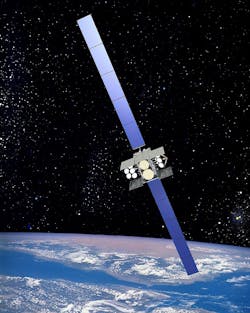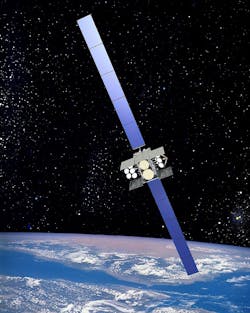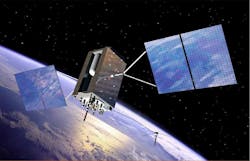NEWS: EMI shielding technology a must for safety-critical systems engineering
Boeing tests anti-jamming technology for satellites, shielding signals from interference
Boeing engineers have proven the company’s new anti-jamming communications technology is capable of operating as either a ground-based user terminal or satellite-based networking hub. The anti-jam technology uses a protected tactical waveform, which shields signals from interference by adversaries or cyber-terrorists. This demonstration complements previous on-orbit demonstrations over satellites like ViaSat-1 and the sixth Wideband Global SATCOM (WGS-6), showing the ability to operate anti-jam waveforms over existing commercial and military spacecraft.
“We’ve confirmed this technology can be applied quickly and affordably to existing assets, especially operational WGS satellites and ground terminals,” explains Dan Hart, vice president of Boeing Government Satellite Systems. “With threats to secure communications becoming increasingly frequent and sophisticated, providing this enhanced capability to warfighters on the ground is critical.”
The technology will enable the military to send and receive secure communications at a lower cost using existing terminals and satellites, officials say.
The test was conducted between a Boeing ground terminal using a programmable modem, designed and developed by ViaSat using one of its commercial off-the-shelf platforms and a ground terminal designed and built by MIT-Lincoln Laboratory. This testing, done under contract for the U.S. Air Force Space and Missile Systems Center and supervised by the U.S. government, confirms that the modem meets technical interface specifications, while transmitting information to and from the ground user terminal.
Exelis GPS threat detection technology now includes improved capabilities
Exelis engineers have enhanced the company’s Signal Sentry 1000, which detects and locates sources of intentional and unintentional interference to GPS signals, with sensors that increase detection accuracy to better pinpoint the jamming source, enhanced analytics to recognize patterns of jamming, and history functionality to comprehend where interference happened and to follow its path. Jamming events can now be instantly reported via text or email so that appropriate resources may be deployed to an incident.
Due to the broad availability of low-cost GPS jamming devices on the Internet, the risk associated with signal disruption has increased significantly, company officials affirm. GPS jammers are often used by criminals to conceal stolen cars and by commercial drivers whose intent is merely to hide their location from their employer. Truckers who used personal privacy GPS jammers near shipping ports have caused interference with the signal also used to navigate large ships, which severely compromised safety and the efficient operation of the port.
Signal Sentry leverages the Global Navigation Satellite System (GNSS) and is based on patented technology developed through the company's history of designing and fielding electronic intelligence systems. “
Signal Sentry was developed by Exelis to protect critical infrastructure and to deliver intelligence to police agencies. Since Signal Sentry has been used by law enforcement, we have been able to enhance the products investigative and intelligent-led policing capabilities,” explains Carl Slutsky, product line manager for Signal Sentry at Exelis. “Now, users can see patterns such as what happened and when and where it happened to better allocate their investigative resources.”
Exelis deployed and tested Signal Sentry 1000 during GPS jamming trials in Sennybridge, United Kingdom. Signal Sentry 1000 was able to detect and geolocate stationary and moving jammers in both open and obstructed environments.
The trials were managed and administered in the U.K. by the Defence Science and Technology Laboratory. Off-the-shelf jamming devices, available to purchase via the Internet, were used during the tests. Testing ranged from stationary jammers to jammers placed in cars driving through open fields and built-up areas at speeds of up to 40 mph. Signal Sentry 1000 successfully detected and located all GPS jamming during the trials.
Exelis developed Signal Sentry 1000 with Chronos Technology Ltd., which also took part in the trials. “The threat to GPS is being more widely recognized, and we know the risks are increasing,” says Charles Curry, founder and managing director, Chronos. “These tests confirm what we’ve known about Signal Sentry 1000 – it’s a practical solution to solving a real problem."
“Protecting critical GPS infrastructure is extremely important for public safety,” explains Mark Pisani, vice president and general manager of positioning, navigation, and timing for Exelis. “With Signal Sentry, we can identify a jammer located in a moving vehicle up to 10-meter (32.8 feet) accuracy.”
Thin film optical filter blocks laser interference and improves flight safety
Lamda Guard, a subsidiary of Metamaterial Technologies Inc, in the U.K., has developed metaAIR, which uses an array of nano-particles of specific periodic geometry (called metamaterials) to protect flight crews from laser strikes.
metaAir's optically transparent thin film filter, which is more than 100 times thinner than a human hair, selectively blocks narrow-band, specific light frequencies by reflection rather than absorption. The technology consists of metamaterials and can be adhesively applied on existing surfaces, such as cockpit windows or windshields.
Current solutions that block laser light are usually standalone products or instruments such as laser safety eyewear, which can hamper cockpit instrumentation and pilot performance. Such solutions require extra investments in night-vision equipment, such as night vision goggles or head-up displays (HUDs). The metaAIR, on the other hand, is quick-to-install, long-lasting, and more cost effective.
“metaAir can be integrated during either aircraft forward-fit or retrofit operations," mentions Frost & Sullivan Consultant Thomas Saquer. "It requires minimal integration costs; it eliminates complex cockpit conversion, training, and additional certification."
metaAir improves fixed-wing and rotary-wing aircraft flight safety without heavily impacting fleet availability; it does not need lengthy grounding time for integrating the solution. Also, end users do not have to wait for the next generation of safety solutions on future aircraft, metaAir can be immediately deployed on existing aircraft, officials say.
"As a unique participant with an unrivalled solution to improve safety, metaAIR could become a standard in the industry and perhaps, even become mandatory with the passing of stricter safety regulations," adds Frost & Sullivan Industry Analyst Alix Leboulanger.




